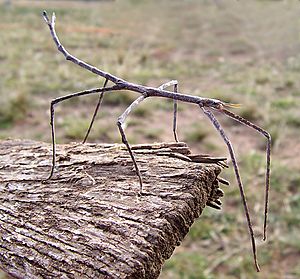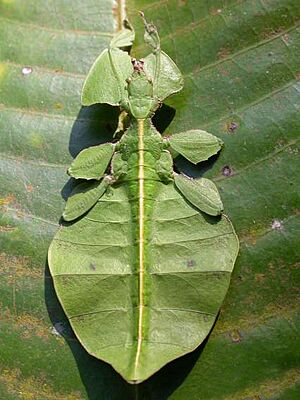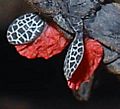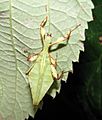Stick insect facts for kids
Quick facts for kids Stick insectTemporal range: Eocene – Recent
|
|
|---|---|
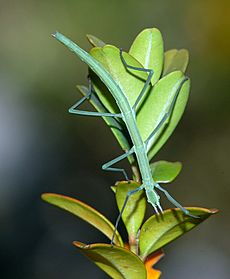 |
|
| Leptynia hispanica | |
| Scientific classification | |
| Kingdom: | |
| Phylum: | |
| Class: | |
| Superorder: | |
| Order: |
Phasmatodea
|
| Suborders | |
|
|
Stick insects are amazing insects. They belong to a group called Phasmatodea (say: Faz-ma-TOH-dee-uh). This name comes from an Ancient Greek word meaning "phantom" or "ghost." This is because they are masters of camouflage!
These insects are famous for looking exactly like their surroundings. They can look like sticks, leaves, or even bark. Some, like Leaf insects, are part of the Phylliidae family. You can find over 3,000 different kinds of stick insects all around the world. Most of them live in warm, tropical places.
Contents
Life and Habitat
Stick insects live all over the world, but most prefer warm, tropical areas. In these places, you can find them looking like sticks, tree bark, leaves, or even moss and lichen. Some stick insects can grow very long, over 13 inches (33 cm)! The longest one known is called the Chan's megastick.
Some types of stick insects, like Carausius morosus, can even change their skin color. This helps them blend in perfectly with their surroundings. Many species do not have wings, or their wings are very small.
Stick insects are herbivores, which means they only eat plants. They mostly munch on the leaves of trees and bushes. Their eggs are often camouflaged too, looking like tiny plant seeds. These eggs can stay hidden and unhatched for a long time, sometimes over a year! When the eggs finally hatch, the baby stick insects, called nymphs, already look a lot like the adults.
Amazing Behavior
Stick insects have some cool behaviors that help them survive.
Swaying Movements
You might see a stick insect swaying slowly from side to side. This movement looks just like a twig or a leaf moving in the wind. It helps them blend in even better with their environment. It might also help them see things around them more clearly, especially when they are not moving much.
Defensive Spray
When a stick insect feels threatened, some species can shoot out a special spray. This spray has a strong, unpleasant smell. The insect gets the chemicals for this spray from the plants it eats. For example, a tribe in Papua New Guinea even uses the spray from one type of stick insect, Megacrania nigrosulfurea, to treat skin infections because it can kill bacteria!
Mating Habits
Stick insects can stay together for a very long time when they mate. One type, the Indian stick insect Necroscia sparaxes, was seen mating for 79 days straight! It's common for some species to stay in their mating position for days or even weeks. Scientists think this long pairing might be a way for the male to guard his mate from other males. It could also be a way for them to protect each other from predators.
Clever Defenses
Stick insects are masters of camouflage. They are all great at mimicry, meaning they look like something else in their natural home.
- Some species, like O. macklotti, have bumpy skin that looks like moss or lichen. This helps them hide even better.
- Certain stick insects can change their color as their surroundings change. This is like having a built-in chameleon power!
- Many species do a rocking motion, swaying their bodies from side to side. This makes them look like leaves or twigs blowing in the wind.
- Most adult stick insects eat at night. This helps them stay hidden from animals that hunt during the day.
Secondary Defenses
If a stick insect is found by a predator, it has other tricks up its sleeve:
- Playing Dead: They might suddenly drop to the ground and stay perfectly still, pretending to be dead. This is called "thanatosis".
- Startle Displays: If a predator gets too close, some stick insects will flash bright colors or make a loud noise. Some will drop to the ground and quickly open their wings to show bright colors. These colors disappear when they land, making them hard to find again. Others might keep their display going for up to 20 minutes, hoping to scare the predator away.
- Ant or Scorpion Mimicry: Young stick insects of some species, like E. tiaratum, can curl their abdomen (their tail end) upwards. This makes them look like ants or even scorpions, which predators usually avoid.
- Spiny Legs: Some stick insects have sharp spines on their front legs. When threatened, they curl their abdomen up and swing their spiny legs together. If they catch the predator, the spines can cause pain and even draw blood.
- Nasty Chemicals: A few species have special glands that release bad-smelling or stinging chemicals. These chemicals can irritate the eyes and mouth of a predator. Some stick insects can even bleed a distasteful fluid from their leg joints when bothered. Like grasshoppers, they can also vomit up their stomach contents, which predators find yucky.
Where They Live
Because of their amazing camouflage, stick insects can be very hard to spot! They live all over the world in warmer areas, especially in the tropics and subtropics. You'll find the most different types in Southeast Asia and South America, and also in Australia. There are also many stick insects in the southeastern United States.
Main Groups
The two main groups of stick insects are:
- Phasmatidae: These are the stick insects that look like twigs.
- Phylliidae: These are the leaf insects that look like leaves.
Stick Insects as Pets
Many stick insects are easy to care for, which makes them great pets! Almost 300 different species have been raised by people.
Images for kids
-
Head of a female Extatosoma tiaratum
-
Hindwing startle display of a male Peruphasma schultei
-
True leaf insects, like this Phyllium bilobatum, belong to the family Phylliidae.
-
Acanthoxyla prasina or the prickly stick insect, native to New Zealand, is believed to reproduce by parthenogenesis; no males have been found.
-
Painting of Leaf Insects and Stick Insects by Marianne North, 1870s
See also
 In Spanish: Phasmatodea para niños
In Spanish: Phasmatodea para niños


